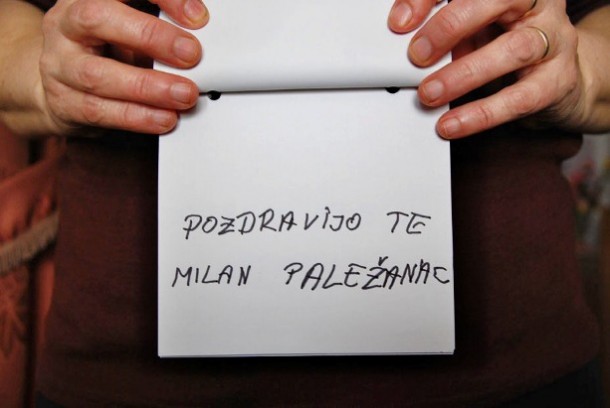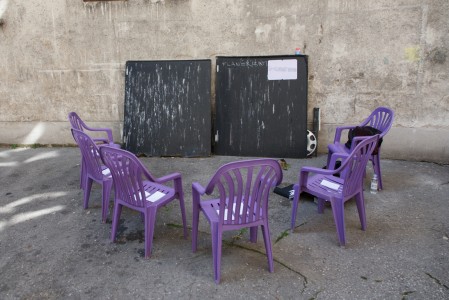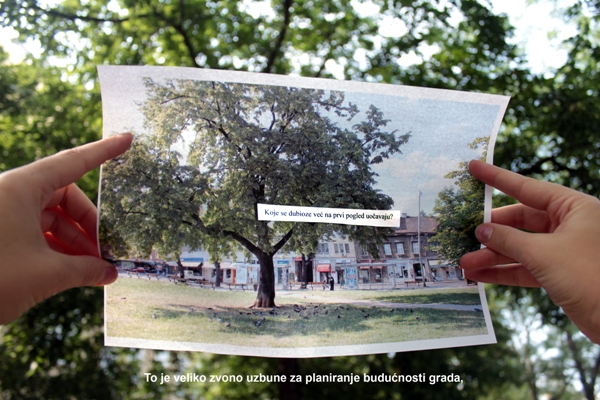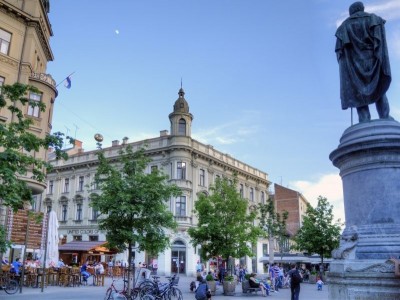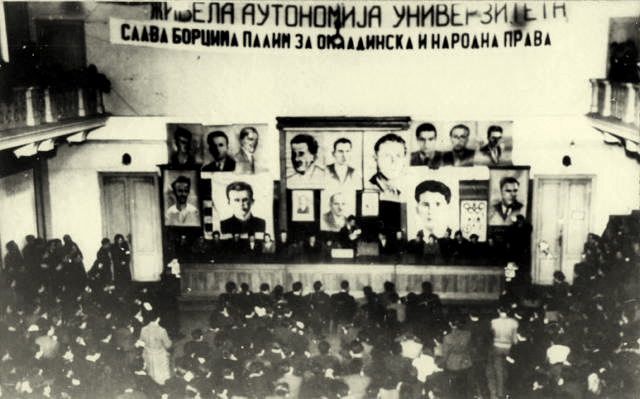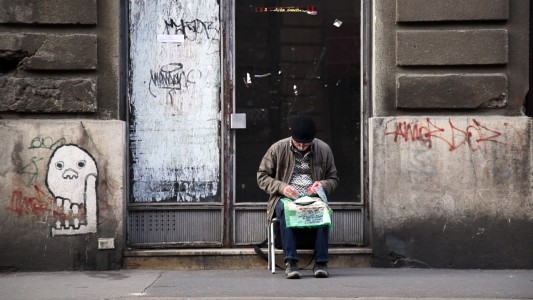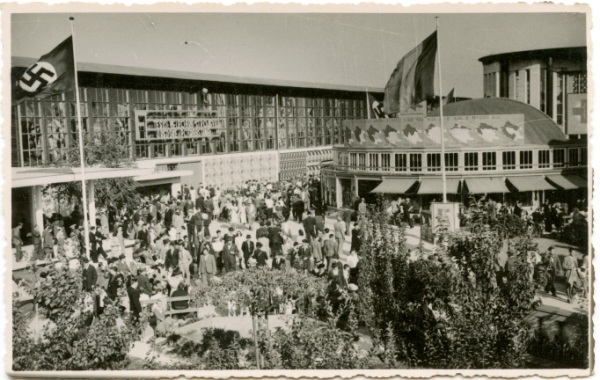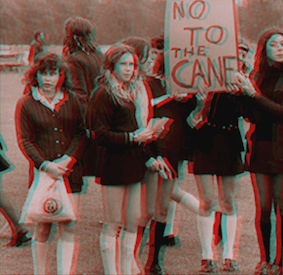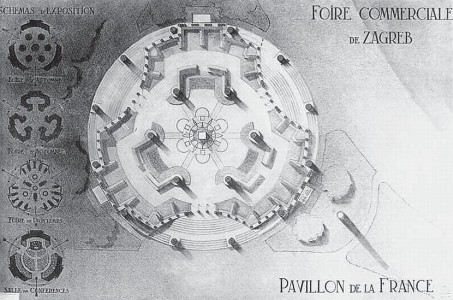Franjo Tuđman Square – From Tuđman’s Workshop of Privatization
Franjo Tuđman Square – From Tuđman’s Workshop of Privatization
It is the autumn of 2012. At the 13th Venice Biennial of Architecture, Croatia is represented by Pula Group. Their pavilion, named Direct Democracy Demands Direct Space, is an answer to the central theme of the biennial – which is Common Ground. The focal point of Pula Group’s exhibition is the map of the struggle machine assembled – a geographic map of the Croatian protest topography. By using collage-type overlapping, the originally heterogeneous points of civic resistance such as Katarina, Muzil, Srđ Is Ours, Jadrankamen, Petrokemija, For Marjan, 3. Maj, Right to the City, and Kamensko, have been combined into a single mechanism, under the flag of political struggle for common good.
The exhibition catalogue includes interviews which the members of Pula Group have conducted with participants of the mapped struggles, with the aim of methodological generalization: What interest us are the interconnections of struggles within the city and the way they expand the radius of the fight. To illustrate it with an example of a destroyed textile factory Kamensko in Zagreb: the workers there went on strike due to unpaid wages and student activists were the first in to support the struggle. Through communication with the workers and some other information that they had access to, they realized that the root of the problem was in fact the speculation over the factory real-estate. After that, they connected them with The Right to the City.[1] Let us focus on one of the twelve cogs on the map of the struggle machine – the site of Kamensko factory on Franjo Tuđman Square: why did I, when choosing from a myriad different narrative strategies, decide to start this text about the square with Pula Group, rather than a direct quotation of a Kamensko worker, for example, and/or the activists gathered around the Faculty of Philosophy or The Right to the City? Why should the right to represent someone’s political struggle belong to none other than the architects of Pula Group – why enter into an even deeper textual mediation (by representing the representative)?
It is the summer of 2012. Towards the end of his fourth mandate, the Mayor of Zagreb summoned a thematic meeting dedicated to finding a spatial solution for the railway network [...]. The idea has come from architect Nenad Fabijanić, head of the working group Integrated City, which in 2010 proposed a solution according to which the railway tracks would be removed from the urban area and relocated to an underground corridor. That would enable the unification of the hitherto separated segments of the city and a more harmonious development in the future, as well as liberate large land surfaces, which would then become a new central zone capable of offering metropolitan facilities. Was it an architect who instigated the thematic meeting!? Was it also an architect, the one according to whose projects the Mayor has been building his fountains, to instigate the first meeting in the Mayor’s office? Was it the architect who planned the residential and commercial complex of Cvjetni the one who knocked at the entrepreneur’s door (carrying a bunch of folders overfilled with plans and drafts), and convinced him, albeit unwilling, to come with him to the Mayor’s office?
The issue of reconstructing Franjo Tuđman Square should be opened by introducing the voice of Pula Group because, unlike the Mayor’s urban planners and architects, they are not guided in their approach by petty bourgeois elitism like Fabijanić: Vienna has 700 fountains, Zagreb only 38.[2] We will certainly not find an article on Pula Group in the daily newspaper under the title ”For a Prettier City,” since aestheticism has long (always?) been serving clientelism and gross capital. They are not bragging about empty categories such as “the harmonious development of the city”; instead, they are exploring precisely those political, economic, and social models that the Mayor’s urban planners and architects have been taking for granted, and which precede the production of space. They counter the dominant power constellations – the blend of gross capital and corrupted administration, which predetermines the development of cities – with participatory, directly democratic processes of collective management (such as cooperatives), decision-making (e.g. plenum), and spatial surveillance (such as trade unions), which seek to achieve hybridization between those who produce space and those who use it.[3] The social, political, and spatial consequences of large urban projects, such as the Integrated City, almost automatically generate case studies in which Pula Group analyses and uses them to produce critical theory, while their role as the representatives of national architectural practice in Venice remains, at least for now, a mere moment of disciplinary commodification, paying representational service to the global trend.
So what do the processes of management, decision-making, and surveillance of spatial production look like in case of the Integrated City, compared to the representational imagery of the Biennial? The administrative top is reserved for the Mayor, eager and rushing to inscribe himself spatially into Zagreb’s history. His decisions, guided by personal ambition, also power other administrative centres of the city: the study was commissioned by the municipal offices for spatial management, urban construction, communal services, and transportation, supported by the Municipal Office for Strategic Planning and Urban Development of Zagreb. The public was excluded from the decision-making process right from the start, since the formal requirement of launching a public competition was ignored. After all, there would have been no time for its execution – the fourth mandate is slowly coming to an end. Under the time pressure, it is enough to inform the public about a ready project: we have decided, among other things, to demolish 70 thousand square metres of buildings (including those in Talovčeva Street and the Sports Centre in Trešnjevka[4]) in order to connect the districts of Črnomerec and Trešnjevka in a megalomaniacal action of transferring seven kilometres of railway tracks underground, building a six-storey administrative building on French Republic Square – popularly known as Keglić – and turning Franjo Tuđman Square into the central city park (with its water features and a number of small bridges, Zagreb will finally be able to compete with Vienna!).[5]
Only two weeks after the project exhibition was opened at Forum Gallery in 2010, the workers of Kamensko, not having received their salaries for several months, occupied the yard in front of the factory on Franjo Tuđman Square in a nine-month hunger strike. Assisted by activist organizations and students, yet abandoned by the factory administration, the State Attorney’s office, and the trade union, they achieved bankruptcy, but the spatial visions of the workers and the new owners did not match. The planned translocation of the factory, the recommencement of production, and the payment of delayed salaries seemed marginal in terms of the market, unimportant and burdening compared to signifying the factory space as reduced to its essentials – as real-estate. The Integrated City determined the value of that real estate quite directly: the land plot coincided with the locality foreseen for the noble construction of metropolitan facilities, namely the residential and commercial complex.
Briefly, the architects’ endorsement of the interests of gross capital and the systematic destruction of Kamensko are parts of the same process: A case study for that area was made in 2005. It suggests that there should be an „oasis for business and park facilities” there. The factory building is attached to two residential buildings. The factory directors visited those residents offering to replace their apartments with others on the outskirts of the city, which are owned by those same directors. It was obvious that the construction firms were involved, but as our business was doing well, we did not believe that they would shut down production.[6] If the Mayor manages and decides together with the administrative power centres, who is doing the surveillance? Instead of the trade unions, surveillance over the production has been taken over by those with a property share – tycoons, marketing imperialists and media moguls, the usual protagonists who emerged in the 1990s from Tuđman’s privatization workshop.
An inhabitant of the neighbouring Čanićeva Street recalls the strike in the following words: Frankly, when those women put up those tents there, for me it was simply unbelievable. Those photos, their rugs and sheets drying on the fence of the handball field… While we were standing there with them, listening to what the television said [...] I don’t know if I have ever been struck by anything like that. Because there you actually see how indifferent this society is. No one cared. [...] I am afraid, and it is connected to the destruction of Kamensko factory, which is only one crime in many, that it is planned as an entertainment zone for those new users, all terribly flashy, that residential and commercial shopping mall that they intend to build here. I am trying to prepare myself mentally – for that moment when I will no longer see the concrete façade of the old Kamensko – because it will change so much the way we live that I have no idea how to prepare myself for that.[7]
It is the winter of 2006. The nameless meadow created in 1978 by demolishing the complex of Rudolf’s Caserns, colloquially known under the name of the neighbouring French Republic Square, was named after the first Croatian president during the third mandate of today’s Mayor. The rightists were furious – left the city hall – because they said that the meadow, even though linked to Tuđman’s victorious speech of 1990, was not historically relevant. As if one needed a deeper synergy of meaning between the levels of connotation that had been already there, a name inscribed on a street sign and a personality denoted by it. The impending reconstruction of the square may indeed help to correct that discrepancy of connotations, for could there be a more adequate monument to Tuđman’s privatization than an exceptionally productive factory systematically destroyed by the neoliberal logic and by manipulations in the form of raising the market price of the land plot and the property itself to the detriment of production, the producers, micro and macro economy, the end users, the continuity of memory, public interest, and morality as such?
Bojan Mucko
[5] Cf. Dinko Milas, “Zaustavite Fabijanića!: Protest protiv gradnje na Trgu Francuske Republike” [Stop Fabijanić!: Protest against the Construction on French Republic Square], Nacional no. 779 (19 October 2010).
[6] A worker of Kamensko, in an interview called “Mi smo uništeni kapitalizmom” [We were destroyed by capitalism], conducted by Jelena Miloš, http://praksa.hr/kamensko/#title (last accessed on 23 September 2012).
[7] From the transcript of an interview conducted by the curators of UrbanFestival.
Flower Square: A Draft for Its Spatial Decoding
Halting for a moment on Flower Square (Cvjetni trg) while strolling around the city, and stepping onto one of its new, freshly laid granite slates, you have positioned yourself into the dense and controversial semantic field that can be interpreted only by decoding its spatial components. If you turn your back to the statue of Preradović, you will have the neuralgic point of the commercial and residential complex “Cvjetni” on your right, while further on, somewhat to the side, you could until recently see a sign with a disturbingly imposing inscription spelling RECONSTRUCTION WORKS. The rectangular fire site behind it belongs only formally to the public space of Varšavska Street, which starts just around the corner. Straight on, you can see the intellectual section of špica (which is where the Zagrebers meet on Saturday mornings to see and be seen) – namely the row of cafes in Preradovićeva – while behind you and to your left, in Margaretska and Bogovićeva, you may experience its more glamorous rills, targets of the yellow press which flow according to the representational rituals and the urban imagery of a society in transition.
Raising your eyes towards the large LED screen, which was installed on the roof of the building on the corner of Preradovićeva earlier this year, may serve as a good narrative intro to our spatial decoding. Among the first programmes transmitted there, back in the times when the first reconstruction of the “Cvjetni” complex was drawing to its end, was a Levi’s TV commercial using the motto “go forth” in order to evoke scenes of youthful freedom, living on the edge and feeling alive, a typical scenario that constructs the consumer of the liberal economic system by investing him or her with the freedom of choice and with individuality. In that commercial, young alternative and independent people, uniform in their Levi’s jeans, were raising their hands while standing alone on the horizon of their free choice – using the same gesture while looking at the rising sun from the rooftop of a derelict building, in the front lines on a rock concert, and – as the climax – while facing a police squad in the first lines of a mass protest. The launching of this commercial, shot in Berlin, coincided with the “civil unrests” that happened last year in London, and only half a year later it was shown on Flower Square, ironically close to the site of protests in Varšavska Street. This appropriation of the iconography of civil disobedience, staged for the benefit of marketing and large corporations, which reduced political struggle to a lifestyle, was a spatial intro to a far more dangerous political appropriation, linked to the point which may serve you to ground your position now – the granite slates on which you are standing.
The sign informing about the “RECONSTRUCTION WORKS” was placed on the corner of Varšavska Street in November last year by the Mayor, and was intended as an info point that would announce the planned paving of Flower Square and the surrounding streets with granite slates, according to the original project from 1995 (which then remained uncompleted because of the tight budget). The sign informing about the project was accompanied by a several meters high Flower Horse, which bore a metal board for attaching opinion sheets and a mailbox set among the flowers – asking the citizens whether they wanted Flower Square reconstructed or not. Asked by a woman journalist whether the public opinion would really influence the outcome of the project, the Mayor responded with a narcissistic image, uttered with the usual sexist connotations: “if the citizens say that they don’t like it, then this will remain – and you can go on destroying your high heels. These hexagons will remain. That is the answer to your question. [...] And then – why a horse? Well, doesn’t it remind you of my personality? What is a horse? A horse likes to work, it pulls and toils. And all that is sublimated in me. And moreover, it is good at that“.[1] When the journalist mentioned the possible link between the recently opened commercial complex of entrepreneur Horvatinčić and the revival of the idea to reconstruct the square, which amounted to rendering permanent service to private capital under the pretext of public good, he said: “I wouldn’t go into such historical reminiscences – my cerebrospinal system is unable to grasp such things“.[2]
The Flower Horse was indeed a product of overt and shameless sublimation – the Trojan Horse of Varšavska symbolized both an attempt to hide private capitalist interests behind the claims of public good, and the civic protest against the corruption policy that supported those interests, and after it was destroyed by municipal bulldozers, after the ramp was cut through the street and the “Cvjetni” complex was inaugurated despite all public protests and unnecessary arrests, the Flower Horse appeared as a brutal symbol of corruption policy that went hand in hand with large capital, as well as of their superiority over the categories of public interest. Its revealed character as a Trojan Horse, the organized civic disobedience, and the struggle for public interest with a politically clearly stated demand for civic participation in creating the city – all these dangerous impulses of democratization – were sublimated in the petty euphemism of Flower Horse in the consciousness of an openly hegemonic system that completely stupidly faked the possibility of civic participation. Taking into account the proclaimed culture of oblivion, which is inherent to such a system – today, when the works on “Cvjetni” are drawing to a close – it may be useful to recall how exactly the citizens reacted to the enquiries about the reconstruction? So that on several occasions they set on fire both the opinion sheets and the horse itself. The horse burned in a sort of pre-Christmas atmosphere – on Christmas, on Carnival, and on Easter – and the burned lot was then covered with brand new granite slates – so much for the desire of public opinion.
Cerebrospinal memory blocks are a part of the hegemonic system – very directly and non-ironically – and have been equally used by the entrepreneur who stands behind the “Cvjetni” complex: “For millennia Zagreb has witnessed the creation, empowerment, and then oblivion of social values and norms, which have always ceded before new, more courageous and more modern ideas.”[3] The evolutionist logic of capital is here expressed very clearly – in order to be substituted through something more modern, social values first have to fall into oblivion. A city square transformed into the foyer of a shopping mall is an ideal phase in the production of oblivion: “At times it may seem as if the whole city has come to Flower Square in order to rest a little, to catch that moment in which the basic everyday life is forgotten, the moment in which one simply lives well.”[4] And the new špica, created only some months after the complex was inaugurated by linking together a number of cafe terraces that connect the interior of the business and commercial centre with Varšavska Street and the square, should offer the needed recipe for amnesia: “It is a place where you will at once feel the new pulse of the city, where something is going on all the time, where entertainment, good life, and all the best that Zagreb can offer have found their home.”[5] But what exactly could it be, that basic everyday life which is forgotten at špica as the place where entertainment and good life have found their home?
The area denoted by the term “špica” has had its own life since the 1950s and, viewed diachronically, it has evolved from the corner of Hotel Dubrovnik through Gajeva Street to Charlie’s cafe, and only from the 1990s gradually towards Flower Square and into the side streets. Its spatial evolution has coincided with the typology of a society in transition, according to the canon of lifestyle magazines and TV-shows – Bogovićeva Street, around the “Grounded Sun”, and Flower Square are places where celebrities, gold diggers, sportsmen, and tycoons meet to have their coffee. The “intellectual” part of špica stretches behind Tesla’s monument along Preradovićeva Street towards Flower Square, vanishes for a while, and then reappears in Varšavska, in front of Cinema Europa. In terms of space, it follows the “new wave” itineraries of the 1980s, embodied in the gravitational points of Masarykova Street (Kavkaz, Zvečka, Blato). In a newspaper article by Tihomir Lešić from the 1970s, špica – at that time the corner of Hotel Dubrovnik – is idealized as a public space par excellence:
“Zagreb has its “špica”: it is the corner of Republic Square and Gajeva Street. And as an institution, it is completely unique. It is not a Hyde Park. It is a corner filled with people, in which a Bosnian quarrels with a Dalmatian about who plays better football. It is a site of strife and debate, of outwitting and outfoxing the other. Ideas soar in all directions. It is the place where captains of the national team are elected and fired, where results are predicted. Lawyers should come here for a practical course in rhetoric, because each and every man is a small Cicero. Whoever does not know the soul of špica, whoever has not spent long sunsets there, may even think that the guys will go for each other’s neck. But that has never happened at špica. It is a place where people use ideas to fight their duels. Most of them do not even know each other’s names, but that doesn’t matter. Here, at this corner, it doesn’t matter who is who, only what he or she has to say. Total democracy. [...] You will be better informed on the political and economic situation by coming here than by reading any newspaper report. Here a professor will have a duel with the peasant woman Jalža or Bara, and none of them will give in. [...].”[6]
To be sure, this corner democracy of socialist multiculturalism was just as much a stylized construct as the description of today’s špica on the leaflet of the shopping mall, but contrary to the present-day špica of consumerist “unity”, the essence of that socialist utopia was the supposed equality of rhetorical competences. That premise, which did remain politically utopian at the corner of Republic Square, was partly realized in Varšavska in 2010 and 2011, when indeed the university professors and the peasant women Jalža and Bara, the Dalmatians and the Bosnians, the senior citizens from the neighbourhood, the cultural workers, and the intellectuals participated in what was truly a political moment on that diachronically opposite end of špica – in Varšavska Street – and they were all grabbed by the neck by the police in defence of private capital. That political moment is the basic everyday life, the essential material of consumerist amnesia that the Mayor and the Entrepreneur have been equally relying upon. In the meantime, the users of Flower Square and the surrounding špica as a public space remain condemned to small consumerist strategies – production through consummation, or rather through rejecting consummation. What shop to enter, where to have your coffee – these have become political decisions.
Bojan Mucko
[1] The transcript of the video was published at Zagreb Online on 4 November 2011; VIDEO: Renoviranje Cvjetnog trga za 8 milijuna kuna [Reconstructing Flower Square for 8 million kunas] (last accessed: 6 June 2012).
[5] From the leaflet of “Cvjetni” shopping mall, announcing the opening of cafe terraces within the centre under the title “Stvorena je nova špica” [The new špica has been born]; 7 July 2011.
What awaits the Student Centre
While the student protests around the world indicate systemic deficits, as well as the fatal consequences of the private system of university education, the dominant discourse in Croatian public still operates with the infantile fantasies about the omnipotent market as the optimal regulator of all aspects of social life. In that sense, the struggle for the preservation of Student Centre as an integral part of the utterly publicly financed university, as well as more broadly of the system of higher education, is a part of the wider political struggle for a re-articulation of the public sphere and the abovementioned systems as its crucial factors.
Goran Pavlić, member of Student Council of University of Zagerb
The history of venue at 25 Savska Road, where Student Centre is located today, can basically be narrated in two chapters, the first beginning with the construction of a “pavilion complex in the best tradition of functional European fairgrounds architecture”[1] in 1936, and the second with the “great student victory” – the solemn inauguration of SC in 1959. At that time, “students and student services occupied the rooms that were especially reconstructed and added for their needs, such as study, culture, education, and entertainment.”[2] Thus, two different social purposes were successfully merged in a single spatial unit: in the first case, it was the encouragement of production (primarily local) and commerce, while in the second, it was the fulfilment of the student needs, joined by a common goal: culture. And while the “Fairgrounds began to attract wider audiences owing to its attractive programmes, gradually turning into a focus of social life, whereby its role in generating modern culture increased in importance,”[3] from the late 60s until the mid-80s Student Centre produced precisely a critique of that modern culture, becoming a cradle of art that dethroned the modern artist as the producer of new and original objects for comfortable urban apartments.
In a simplified history of SC, we might say that one vision of culture substituted another, asserting the student population as having a revolutionary (or at least subversive) potential, also in the field of art, since it rejected the established canons, acted in alternative directions, invented new practices, questioned the basic tenets, rejected the product while affirming the process, criticized the society, and redefined the audience.
In a less known history of SC, one will find additional chapters, such as the one beginning in 1941, when the purpose of the venue remained the same, only that the encouragement of production and commerce, and the “generation of modern culture,” now took place under the ustasha emblems and the swastika. In May the same year, the “functional European fairgrounds architecture” revealed itself as very suitable for a new use under the same symbols: it became a transit camp. “Late in June 1941, the Jews of Zagreb were seized by considerable panic: no one could be sure to avoid arrest. The locality was carefully chosen, since it was isolated enough to be suitable for surveillance and guarding, and it was connected through industrial sidings with the rest of the railway network, which made the deportations easy. The internees were mostly accommodated in the French Pavilion, and some of them in the neighbouring two pavilions. At first they slept on bare ground, and on 27 June some straw was brought to them. There were always wagons on those railway sidings, and if someone in charge decided that a sufficient number of internees were collected, they would be loaded on wagons at night and deported. Those kept in other pavilions did not know what was going on, especially at night, since they were not allowed to leave their pavilions.”[4]
If the culture of the 1960s and 1970s criticized modern culture, which had in 1956 moved with the fairgrounds to the other side of River Sava, it apparently would not criticize the “European functionality” of SC which had, following the Nuremberg Laws, took to death so many of their political adversaries and racially undesirable neighbours – since despite the anti-fascist background of new Yugoslavia and a great number of memorials dedicated to the victims of fascist terror, the sufferings that had taken place at this particular site were never commemorated, like a denial that could not be faced since it avoided all denotation in language/discourse/understanding.
Another untold chapter from the extended history of SC began in the 1990s, and perhaps it has remained untold because at first glance it may seem as if it has never really begun: despite the overall privatization of public property and social ownership, which started with the fall of Yugoslavia and the political/economic pacts benefiting private interests, SC has remained public. Regarding the fact that its mode of operation remained unchanged, it could continue its existence, together with the University, in the autonomous zone in which cultural critique was generated. From today’s distance (that today having lasted for years and years of transition), we can see, however, that the new chapter has begun after all, and that behind the curtain of new Croatian statehood all public goods have been questioned and brought to a more or less gradual demise, even if remaining officially non-privatized, which now means state rather than social ownership. In case of SC, as well as many other cultural institutions, which may have felt even stronger this change of cultural paradigm, it has been not only state, but also state-making ownership, as it has been observed by art historian Darko Glavan: “While most directors of SC Gallery shaped their programme in terms of more or less covert confrontation with disciplinary authorities and specific institutions (mostly systematic resistance against the Academy of Fine Arts Zagreb, or rather its conservative and traditionalist principles), Ms Domić tried to formulate the programme of SC Gallery as a basis for the then popular “intellectual renewal.”[5] However, it was not only the cultural paradigm that was changed, but also the economic one, which meant that the ways of financing, which had enabled SC for decades to offer free or very accessible cultural programmes to students (who were also freed from tuition fees), was substituted by the principle of private interest, where the allegedly public good was handled so as to bring private profit.
Today, in the epilogue to this story, the understanding of culture as a means of boosting national identity after Tuđman’s death and the elections of January 3 has been slowly substituted by the culture of change, which is also the title of the general concept of SC’s cultural programme, which is based on the principles of optimal use of the existing space, contemporary topics, student participation, and encouragement of international cooperation.[6] However, on the economic plane the change has not happened: management according to the principle of serving private interests has continued and resulted in SC’s debt of a hundred million Kuna.[7] This has prepared some empty sheets for the first pages of the new chapter, in which the purpose of SC will be private and commercial, while its owners will be its present creditors, consumer-goods companies that have allowed SC’s debt to grow for many years. Perhaps SC will then become the focus of a new, very modern culture, based again on consummation (although no longer on local production), which will be sold to the students together with the newly imposed tuition fees.
In the efforts to clear the way for such future, it is precisely culture, in the form in which it is still striving to survive at SC, which is doomed to be erased first. As Goran Pavlić has observed, “the current suggestions [for dealing with the debts] do not go further than merely palliative measures, among others the one from the classical repertoire of reactionary imagery: culture does not create profit, so we must think of discontinuing significant finances in this respect, as well as of reorienting it towards entertainment in order to earn at least something. This attitude, openly endorsed even by the former student representative at SC, with the corresponding cultural-chauvinistic remarks that foreigners have been writing for Croatian stages for our money, only reveals the systemic lack of understanding for the role of open and experimental cultural platform.”[8]
In the times when one may conclude that the number of people attending a cultural event is reverse proportional to the amount of public money taken by the organizers, while the events that the masses, by the same logic, like and visit are in themselves a result of transparent use of public money, which is in the public interest and accidentally also in the interest of those who trade with fast food and beer – in such times it is not too comfortable to divulge our brief history of SC and to ask ourselves why Zagreb Fairgrounds could once continue their annual exhibitions under the Nazi flag. Apparently, a place will change its purpose only when the real change, the ideological one, has already taken place, brought about by the silent and invisible processes of manipulation.
Extracting the unpleasant historical chapters (which the public spaces of Zagreb abound in, whether connected to World War II or the more recent war in Croatia) from the sphere of denial means initiating another aspect of culture, the culture of remembrance, where commemorating a site of suffering is considered a question of public interest and a process that can surpass the culture of oblivion only by remaining permanently present in the sphere of public discourse. Discussing processes hidden behind the terrors of war, as well as the policies of oblivion that tend to push them into denial, is also a discussion about chapters that might yet happen, in which contemporary fascism goes hand in hand with the erosion of the public sphere and social life.
Ana Kutleša & Ivana Hanaček
[1] Jasna Galjer, “Art deco u primijenjenoj umjetnosti i dizajnu” [Art Deco in Applied Arts and Design], in Art deco i umjetnost u Hrvatskoj između dva rata [Art Deco and art in Croatia between the two World Wars] (Zagreb: Museum of Arts and Crafts, 2011).
[2] From the materials on Culture of Change
[3] Jasna Galjer, op. cit.
[4] Ivo Goldstein, Holokaust u Zagrebu [Holocaust in Zagreb] (Zagreb: Novi Liber, 2001).
[5] Darko Glavan, 40 godina Galerije SC [Forty years of SC Gallery] (Zagreb: Student Centre, Kultura, and SC Gallery, 2005).
[6] From the unpublished study “Studenti i kultura promjene” [Students and the culture of change].
[8]Goran Pavlić, interview for the curatorial team of UrbanFestival 12 (2012), unpublished.
Thank you for your cooperation, we are closed until further notice – Emptied in Restitution
A stroll through the streets of the wider city centre of Zagreb is accompanied by the powerful rhythm of spatial caesuras – empty, closed shops. Once the key commercial veins of the city, such as Ilica, Tratinska, or Maksimirska, full of small craftsmen’s shops and representative shop windows, have become transitory corridors emptied of all substance. Some of them have been standing empty for as long as ten years, while others have been changing their function almost on a monthly basis, determined by the method of trials and errors in testing the recession market. At the same time, other types of shops have been appearing and metastasizing sporadically through the city as a result of global financial manipulations – among them, hundreds of shops specialized for buying precious metals. This process is somewhat like a late capitalist inversion of the relations of money and commodity: spaces of supply have been transformed into places of demand; they are asking for commodities and offering money, reducing cultural memorabilia to their exchange value. Their users are granted full discretion and allowed to hide from the public gaze, which is why these shops are completely closed towards the street, in a consumerist antithesis to the visual transparency of a shop window.
Thus the substantial heterogeneity of hundreds of shops has been homogenized by covering their windows, that is, by functionally reducing them to a void, with identitary consequences on both semiotic and phenomenological levels – the emptied shop windows have lost their original character of communication and persuasion, and yet they catch the gaze, invite interpretations. In his essay on the categories of overfilled and empty – as symptoms of supermodernity – Marc Augé has compared the ruin with a sign without the signified, “or at least without any other signified than the feeling of time itself, passing and enduring at the same time.“[1] Empty shop windows are evocative places of anti-spectacle, with an effect of visual time cracks, but instead of the meditative possibility of escapist immersion in the void, I am interested in the level of precision to which they can be read as a sign of broader social phenomena (whereby I am not referring to simplifications about the recession).
The public space of the street full of empty shops certainly fails to recall Benjamin’s idle stroller, for he has left long ago to wander through the privatized spaces of shopping malls on the city’s periphery. Reflection in these shop windows, reminiscent of the former passages, is still constitutive for the consumers’ identity. Their field of vision is formatted by overlapping their own reflection on the outside of the glass pane with the image of goods exhibited in the shop window; but the reflections of flâneurs in the districts of Črnomerec, Trešnjevka, or Maksimir have already vanished among the contours of densely accumulated sediments of dirt. The only thing they can overlap with are messages such as: “Thank you for your cooperation, we are closed until further notice” or “Shop closed” or “Closed for reconstruction“, or „CITY OF ZAGREB – for further information please turn to the Office for Municipal Assets and Property Management, Department of Commercial Venues Management.”
Unlike Benjamin’s flâneur who, as a victim of the spectacle, led by the euphoric experience of the city, ends up merged with the collective of consumers, characteristics that Chris Jenks has attributed to the flâneur make him capable of critical detachment and position him in opposition against the consumerist culture. Jenks’ figure of the flâneur, influenced by Situationism and the critique of the society of spectacle, has been equally determined by euphoric and dysphoric experience. His trajectory through the city is guided by minatorial geographies, that is, by “that which is experienced by the flâneur both as fascination (as in the dérive) but also as rebuff or even intimidation. Its reflexive recognition [is] interchangeably magnetic and repulsive.”[2] Zagreb’s emptied corridors are such minatorial geographies or, as their users call them – urban appendices. In a country in which social activism is identified with idleness and laziness, field work in these precarious conditions must be idleness, and therefore the title of flâneur remains reserved for the cultural critic.
On several occasions in 2009 and 2012, I ventured into “botanizing” the corridors of Zagreb, first the segment of Ilica around Črnomerec and then Tratinska and Maksimirska streets. My dérive was guided by messages from the field, like in a detective novel in which the main character “decides to go forth in search of adventure by following a scrap of paper which he has given to the wind to play with. No matter what trail a flâneur may follow, every one of them will lead him to a crime.”[3] Messages abandoned to the passing of time on the inside of shop windows reveal, for example, that a three-month interruption of operation because of reconstruction works actually lasted for seven years, or that a municipal venue was rented at the price of surrealistic 88 thousand Kuna, or that the Mayor – who signed the contract – demanded a loan worth millions from the renter as a condition for getting the shop on lease. Many of these stories led to the municipal office in charge.
The official narrative of the municipal authorities focuses primarily on the processes of communist nationalization and transitional de-nationalization, but that macro-narrative has been dissolved by the personal interpretations of those who rent their shops and workshops from the state or the city, craftsmen and small entrepreneurs who have disclosed the property relations between the state and the city as a field of corruption and manipulation. Strategies of renting space in the non-transparent system of a transitional society move in the field between the legal and the illegal naturalized as legitimate.
The story of empty shops goes back to 1996, with the enactment of the Law on Return of Property Expropriated or Nationalized during Yugoslav Communist Rule. The previous owners, or the legal heirs of real estate that had been nationalized by the communists, had only half a year time (during 1997) to apply for the restitution of their property. Except for the fact that the deadline was very tight, the first version of the Law on Return also discriminated according to the nationality; the right to have one’s property returned applied only to the citizens of the Republic of Croatia, and it was only with the modification of the law in 1999 that the possibility was extended to foreign citizens. In 2011, under the pressure of foreign embassies, primarily the US, the question of returning property that had been expropriated during the period of NDH (Independent State of Croatia, 1941-45) was reopened, including the “paradoxical” overlapping of the categories of communist social ownership and the property relations inherited from the previous fascist regime.[4]
As the legal heir of Yugoslavia, Croatia inherited the ownership rights over the formerly social property, which remained at its disposal until the opened restitution processes were resolved. Real estate without legal heirs, such as that which in the socialist era was owned by various foundations, automatically became state property (most of it located in the districts of Centar and Medveščak, partly also in Maksimir, Trešnjevka, Črnomerec, and Trnje). State property was also enlarged wherever the restitution of property was applied for by such physical persons for whom it was established during the process that they had no right to it. The state could let the units of local administration, in this case the City of Zagreb, manage its office space. This means that the real estate that the city offered for rent was either state property – involved in the process of restitution and thus temporarily owned by the city – or municipal property. The latter included the properties of socialist Social and Political Entities or Associated Municipalities (in Susedgrad, Novi Zagreb, Dubrava, Sesvete, or Pešćenica). In Ilica, for example, state property was given for management to the city, but owing to the unresolved restitution processes, the possibilities of renting have remained very limited and a part of the venues stands empty.
Shops have been returned to their former owners in material form, and all contracts signed with the current users cease to be valid on the date indicated in the official decision. Renters have the right to continue using the shop for another year, after which they can either sign a new contract with the new owner, or leave. In many cases the new-old owners will require exorbitant sums as the new rent, which means that the returned shops will often close down and remain empty. Thereby it is hard to understand why an empty space would be more profitable than a used one, and narratives from the field sometimes reveal the motive of “revenge” as an explanation. The expelled renters often feel cheated because they had been investing in the shops for many years without being entitled to any reimbursement from the state or the city, and they often go to court to obtain it.
From the perspective of those who have been renting state and municipal property for years, the greatest problem is the impossibility of buying the property. Since the 1990s they have been promised the right to buy the shop that they had been investing in for decades, and the rent they had paid would suffice to buy more than one. In the first phase of my research, in 2009, craftsmen and small entrepreneurs would often tell me a story that resembled one of those urban myths, namely that in the course of joining the EU, Brussels would force the Croatian state to exert pressure upon the city to get rid of municipal property, that is, privatize it. And indeed, last year we finally witnessed the enactment of the Law on Renting and Selling Commercial Venues, which is supposed to enable those entrepreneurs who have been renting a state, municipal, or communal venue for many years to buy the property without public competition during this, pre-accession year. That would mean that the myth is, after all, a political reality, and that the transition might end with a pre-accession redemption of the original, “East-of-Eden” sin – by erasing all traces of the exotic category of social ownership. But what sort of erasure would that be – acquisition without public competition, on the free market, in the times of economic crisis? Using the words of a tailor from Črnomerec: “And now I have the impression that I am supposed to stay here exactly until I retire, and then foreign, Western capital will come and throw money onto the table of those in power – whoever that may be – and they will give it away, and everyone will have clean hands… There – that’s it. It’s really horrible, I mean really.”
Empty shops are a part of the late capitalist phenomenon of urban implosion – of functional and substantial erosion of the city centre, with constant metastasizing of commercial sites on the periphery. In the context of Zagreb, it has coincided with long-term transition processes of property restructuring. Considering the fact that there are no adequate municipal or state strategies or initiatives of revitalization (apart from those faked in pre-election campaigns), we must encourage interdisciplinary reflexion on these complex economic, legal, urbanistic, and anthropological (…) issues, because the minatorial geographies of Zagreb’s streets are becoming prone to connotations that we have seen in the case of Flower Square, and the said example has also taught us what follows when such “rat tenements” have been detected. We must outsmart the future with its potentially gentrifying, instrumental solutions.
Bojan Mucko
[1] Marc Augé, Le Temps en ruines (Paris: Galilée, 2003), p. 92.
[2] Chris Jenks, “Watching Your Step: The History and Practice of the flâneur,” in idem (ed.), Visual Culture (London: Routledge, 1995), p. 158.
[3] Walter Benjamin, “The Paris of the Second Empire in Baudelaire,“ in Charles Baudelaire: A Lyric Poet in the Era of High Capitalism, trans. Harry Zohn (London and New York: Verso, 1997), p. 41.
]]>
